The dawn of Apps
Certain dates stand out in history and have a special “where were you when …” quality about them – 20 July 1969, 8 December 1980 and 9 November 1989 quickly come to mind. Amongst these dates 10 July 2008 probably doesn’t mean a great deal, however on this day an event took place that has touched the lives of billions of people and, for better or worse, fundamentally altered the way we interact with each other and the world. On 10th July 2008 Steve Jobs launched the App Store for the iPhone. Nearly eight years later, with over 1.5 million Apps and billions of dollars spent, Apps have revolutionised the way we communicate, explore the world, keep up to date, entertain ourselves, hook up for a hot night, and maybe, find a life partner.
The next big thing in the world of Apps is likely to be healthcare and medicine – there are already Apps that allow you to connect to a cuff, take your blood pressure, have it interpreted and emailed directly to your doctor, or using a special lens attached to the iPhone’s camera, check your sperm for motility and abundance.
At NOI, we have always tried to keep pace with technology and apply it within our field of pain education and treatment. The first Recognise App released in 2011 brought with it the ability to quickly and accurately test and train Left/Right discrimination on the go and add powerful contextual variety – the first stage of Graded Motor Imagery could now be undertaken easily on the bus, in bed, or at the place of injury.
Explain Pain 2.0 and the Protectometer
Five years after that first App, advancing technology has allowed us to bring in the next era of Explain Pain. The Protectometer App merges pain education that you can touch, manipulate and personalise, with Challenges that encourage behavioural activation, contextual graded activity and deep exploration of thoughts and beliefs. The entire Protectometer App has been ‘gamified’ to deepen engagement and motivate people to learn more about their pain and achieve their goals. We’d love to take you on a quick tour of the Protectometer App to show you how it will fit into your clinical practice or recovery:
eBook
The Protectometer App contains the first half of The Explain Pain Handbook: Protectometer as an ebook, redesigned for ease of reading on iPad.
The eBook introduces DIMs and SIMs (Danger In Me and Safety In Me neurotags) and their seven categories: Things you hear see smell taste and touch, Things you do, Things you say, Things you think and believe, Places you go, People in your Life and Things happening in your body.
Protectometer
The heart of the App is the interactive Protectometer. Pain ratings can be added and adjusted by simply sliding the indicator up and down. DIMs and SIMs can be added with a tap, and the App allows users to take advantage of their iPad’s camera and microphone to take pictures or record voice notes.
As users discover and add more DIMs and SIMs they are rewarded with Achievements along the way. The Protectometer has a built in intelligence that will ask the user if they are having a flare-up, by gauging significant changes in their pain rating and then suggesting they review the eBook section on managing flare-ups. If a user has entered a significantly reduced pain rating, the App will also identify this and suggest the user update their SIMs to capture the moment – it’s essentially asking, ‘what’s just changed in your life?’
Challenges
People often ask us to to help them with the next stage after Explaining Pain. The Protectometer App introduces an entire new section called Challenges. When a user has entered as many DIMs and SIMs as he can find (remember they can hide in hard to find places), she can tap GO! to be taken to a series of over 40 challenges within the seven categories. All are carefully designed to enhance pain understanding, change thinking and language, and encourage graded exploration of life.
Every Challenge has a catchy name, a simple description of the activity and some biology to back it up. Imagine all the people (words written by the musician who was tragically shot on 8 December 1980) invites the user to visualise a useful outcome of a meeting with another person, or to imagine challenges that might come up in life and mentally run through ways to successfully deal with them. Some users will be comfortable undertaking this exercise on their own, but we know others will seek the help of a health professional and open up a whole avenue to deal with DIMs.
Play with space encourages people to explore their personal space (not the space that was explored on 20 July 1969) and consider gradually letting SIM people back in closer, while giving DIM people a bit of a wider berth. Unblock your language invites the App user to carefully reflect on her language and get rid of unhelpful phrases such as “my back is out” and find some freedom of linguistic expression – for some this freedom could be as liberating as ‘the wall’ coming down on 9 November 1989.
Each category has the ability to add Custom Challenges enabling therapists and patients to work together to set personalised tasks to enhance patient centred, and goal directed therapy. Completing Challenges will unlock Achievements such as DIM Destroyer awarded for completing any 20 challenges or Seasoned Traveller for completing all seven challenges in the Places you go category.
Tracking Progress
The Protectometer App graphs Pain ratings and the DIM:SIM ratio allowing users to track their progress and immediately see the impact that increasing DIMs or SIMs has on their pain experience.
Available on the iPad at present to take advantage of the device’s screen size, the Protectometer App also adds a greater level of security as users can password protect their iPad and feel comfortable knowing that deeply personal DIMs and SIMs will be kept private.
RON is dead, long live Recognise Apps
With advances in the world of smart devices and clever Apps, older technology becomes redundant. And so it is with our (much beloved) Recognise Online (RON). RON has done a huge amount of work for us, and thousands of users over the last eight years and we think it is time to allow him out to pasture for a well-earned retirement. With the release of our brand new Recognise Apps (we’ve written about them at length on NOIjam before) available for iOS and Android, RON will be put out of commission at the end of September 2016.
There are a few important notes for our current RON users:
- If you have an existing licence it will continue to work until the current expiry date (as long as this is prior to the end of September 2016)
- If you have any unissued licenses as a therapist, you will need to provide these to your patients to be used before end of September
- The new Recognise Apps are available on both iOS and Android platforms for smart phones and tablets and will completely replace all the functions of the retiring RON
Set us a challenge
To celebrate the retirement of RON, and the release of our new Apps, we are giving away 5 copies of the Protectometer App for iPad (you need an iPad first…). To be in the running for a Protectometer App, simply leave a comment below with your thoughts on a Protectometer challenge.
Here’s a guide to writing a Challenge:
- Give it a catchy name
- In around 100 words, set a simple activity that will help people find SIMs or demolish DIMs in one of the seven categories (see image above)
- Add a bit of biology to support the activity and some further learning (see image below).
We’ll pick the top 5 Challenges and contact the winners.
-Tim Cocks and David Butler
We’re hitting the road and taking our NOI courses right across this great southern land:
Noosa 17 – 19 June Explain Pain and Graded Motor Imagery (Both courses SOLD OUT)
Wagga Wagga 16-17 July Explain Pain
Perth 15 – 17 October Explain Pain and Graded Motor Imagery
EP3 events have sold out three years running in Australia, and we are super excited to be bringing this unique format to the United States in late 2016 with Lorimer Moseley, Mark Jensen, David Butler, and few NOI surprises.
EP3 EAST Philadelphia, December 2, 3, 4 2016
EP3 WEST Seattle, December 9, 10, 11 2016
To register your interest, contact NOI USA:
p (610) 664-4465
e noius@noigroup.com

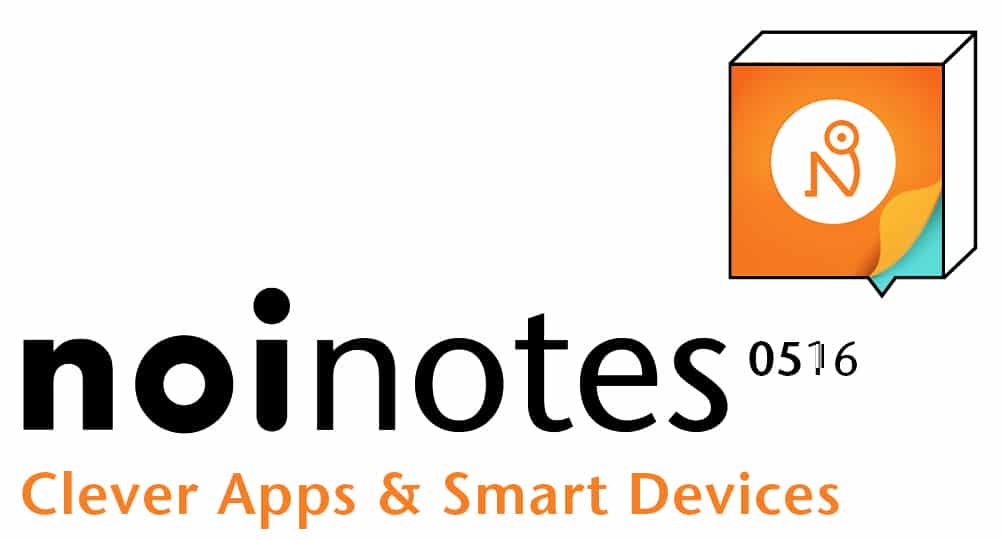

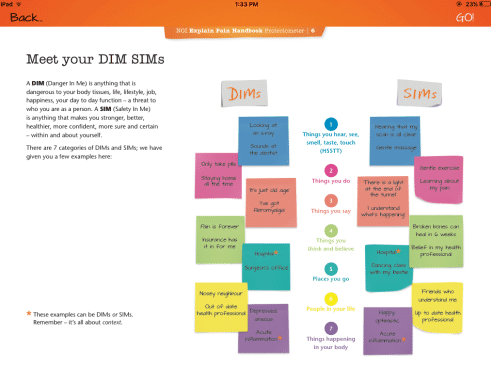
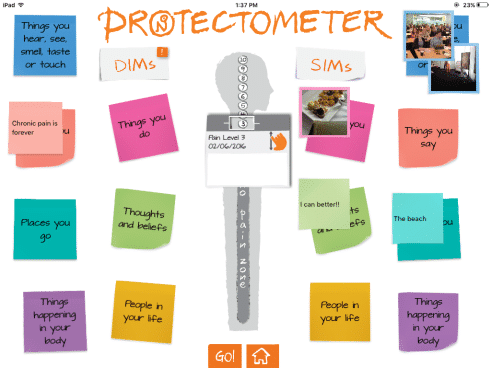

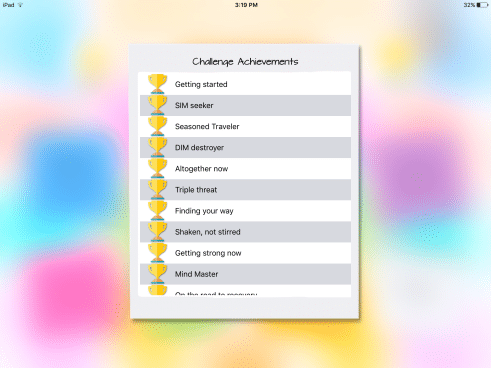

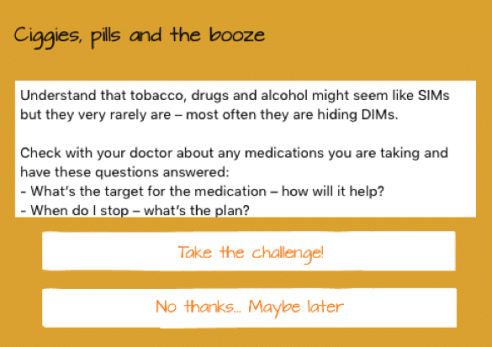
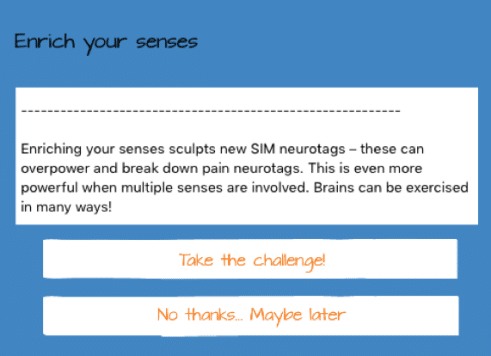
![aussie_tour_banner_2016[1]](https://noigroup.com/wp-content/uploads/2020/11/aussie_tour_banner_20161.jpg)

I LOVE THAT THIS IS AN APP AND WE ARE CREATING CHALLENGES AROUND PAIN RECOVERY.
Name:
Sorry, pushed the wrong button. My entry for the CHALLENGE writing competition is:
Name: Strut your Stuff
How: Exaggerate the following key features of your walking pattern (common to all) and note what arises for you when you do each one:
1) Lean forward from the middle of the chest, without falling over, for 15m
2) Bounce the whole body up and down, as you find the spring in your step, for 15m
3) Place your hands on the outside of your rib cage and lead your walking from here, with a twist of the waist, for 15m
4) Walk for 15m, leading with your knees
Why: Walking patterns change with persistent pain. Common features of walking can get under stimulated and this varies for each individual. We become less dynamic. Wake up each of these areas through the above walking drills and strut your way to pain inhibition and healthy dynamic walking
I like these. There is a bit of Cleese’s “Ministry of funny walks” here!. Very therapeutic. I would also add that in persistently altered gait, every step is a reminder to the brain that the walker is not quite OK and there will be a homeostatic protective response. “Strut your stuff” is a great way to alter walking contexts.
David
Thanks David – it’s great to reflect exactly on the specific impact of the maladaptive on system homeostasis
I have entry number two:
Name: MOJO MOBILISER
How: Move in all three movement directions (across all three planes of movement) :
1) high knee walking or running
2) side stepping of skipping
3) grapevine using arms and legs
AND Answer the following questions about each:
1) Was it scary?
2) Was it hard to initiate or organise myself
3) Was it stiff / restricted?
4) Was it painful?
5) Did it feel coordinated or unco?
Why: Coordinated and variable movement is healthy. Pain causes us to adapt in a way that protects us. Persistent pain often involves persistent adaptation – we call this maladaption. In order to highlight where the subtle whole body adaptations may be located, whole body coordination assessment can help this. By doing these movements and answering these questions, new targets to assist with adaptation OUT OF THE MALADAPTIVE STATE can be identified. If we are bioplastic and motion is lotion, this should be powerful right ??!!
Entry Number Three:
Name: “I’ll give YOU a Tantrum!!”
How: Pick a movement you want to make less sensitive. Decide to “talk your pain down” as you PACE your way back to less protection and more tolerance of the movement experience
Why: The sensitive nervous system needs to be soothed / tamed. And Pacing with Positive Talk is a double strategy to reset the protection line. The positive self talk could sound something like this:
” OK nervous system I am ready for battle. i’m going to wind you down nervous system. YOU HAVE SET THE LIMITS FOR TOO LONG. It’s time I showed you that moving in this way is a healthy, natural and safe. If you have a tantrum or dummy spit with pain again, I’m just going to do it again until you stop responding with pain…. SO settle down nervous system, wind down …..
Because thoughts are nerve impulses too and positive ones can sooth the nervous system, massage the nerve juice flow and reset the brain output. SO GET READY TO TAKE ON YOUR NERVOUS SYSTEM. Bring your “A” game to it, to challenge its dominance and reset its output response.
Currently anonymous, I forgot to sign off – Leanne Rath
Hi Leanne
Thanks for your comments, brilliant Challenges and introducing yourself. I particularly like the Mojo Mobiliser. Got a feeling you’ll be hearing from us – hope you’ve got an iPad!
Best
Tim
Thanks Tim and David. All three of these “challenges” I have developed and regularly use in the clinic with very powerful results. Whatever arises, we target and the ability to use “Strut your Stuff” and “MOJO MOBILISER” to stimulate a self reorganisation is endlessly rewarding. My patients love them!! Leanne
Me again – I really love this challenge and so I’m entering my fourth challenge called:
Name: THE GLAD GAME
INSPIRATION: My sister-in-law who used “Pollyanna’s Glad Game” strategy to get her psychologically through 9 months of cancer treatment
HOW: Employ an optimistic attitude through playing THE GALD GAME with yourself, to replace negative thoughts with a GLAD thought, in response to any aspect of your pain experience
WHY: Thoughts are nerve impulses too – some wise men have highlighted that in the EXPLAIN PAIN book. We know with every negative thought related to our pain experience, we interfere with the happy hormones and promote the biology that will maintain a pain state. In short, our negative thoughts both interfere with our progress with pain recovery and help to feed the maintenance of our pain state. SO being GLAD and intentionally generating positive thoughts around how GLAD we are under our pain experience circumstances (implying things COULD be worse) shifts the biology in the RECOVERY direction. How powerful; how cool; how very in charge I can be!!!
Leanne Rath FACP
Thank you Tracey and Pollyanna for your inspiration
Re- sent as had KEY typo:
Me again – I really love this challenge and so I’m entering my fourth challenge called:
Name: THE GLAD GAME
INSPIRATION: My sister-in-law who used “Pollyanna’s Glad Game” strategy to get her psychologically through 9 months of cancer treatment
HOW: Employ an optimistic attitude through playing THE GLAD GAME with yourself, to replace negative thoughts with a GLAD thought, in response to any aspect of your pain experience
WHY: Thoughts are nerve impulses too – some wise men have highlighted that in the EXPLAIN PAIN book. We know with every negative thought related to our pain experience, we interfere with the happy hormones and promote the biology that will maintain a pain state. In short, our negative thoughts both interfere with our progress with pain recovery and help to feed the maintenance of our pain state. SO being GLAD and intentionally generating positive thoughts around how GLAD we are under our pain experience circumstances (implying things COULD be worse) shifts the biology in the RECOVERY direction. How powerful; how cool; how very in charge I can be!!!
Leanne Rath FACP
Thank you Tracey and Pollyanna for your inspiration
It’s taken me a while to think about these …
Name: Beauty All Around
Activity: Grab a camera, or your mobile phone, and find 5 beautiful things in your immediate environment. They don’t have to be stunning – it might be a dandelion flower, the rug you just vacuumed, or a cushion you’re particularly fond of.
Repeat this activity every day for a week, trying to find different things every time you do it. Notice how it changes your overall mindset when you look for beautiful things every day.
Why: Moving through the world looking for beauty increases general positive thoughts and feelings increases your SIM level.
Name: This Too Shall Pass
Category: Things you think/believe
Activity: Any time you feel your pain starting up, or getting worse, use self-talk to mentally remind yourself that this is a temporary thing. Example sentences might be:
“This too shall pass”
“It’s fine, this is only for a little while”
“I’ll feel better in the morning”
Any sentences that make you feel better about your own pain will be fine.
Why: Expectations are powerful things. Telling yourself over and over that the pain is temporary (even if you don’t totally believe yourself) helps remind your body and brain to be calm and not to panic, decreasing DIM feelings that the pain itself causes.
(I don’t know the technical explanations for most of this stuff – I’m a pain patient, not a clinician – but I’m sure you can write your own if you like these!)
Name: Baby Steps
Category: Things you do
Activity: When there’s pain in an area, instead of keeping still and freezing up, try making little movements in the area where there’s pain. Figure out what direction and speed of movements you can make without the pain intensifying.
Notice that you often find the small movements will help remind your body that it’s really OK and muscles will relax and movements will get easier.
Why: Small movements are less likely to activate your brain’s old unhelpful “protection” programming that makes the pain worse and/or makes you freeze up in an effort to stop the pain. It’s a way around an unhelpful roadblock without setting off the alarms.